Just like that, we’re witnessing another seismic shift among the stars of content marketing. Celebrity endorsements lost ground to influencer marketing around 2020, driven by a pandemic-fueled craving for authentic connection. Now, in the age of trust and transparency and influencer fatigue running rampant, a new content marketer has emerged.
The employee.
What is Employee-Generated Content?
Employee-Generated Content (EGC) is the new driving force of influence in 2025. This revolutionary social media marketing approach can be defined as a form of content created by a company’s current employees. The material gives audiences a more engaging look at company culture, workplace experiences, and employee perspectives on the brand’s product or service.
What might come to mind first are employee contributions via company blog posts, articles and/or long-form, video testimonials. But, brands have more flexibility to lean into EGC than they might think. The marketing methods that drive real success with their EGC efforts often win by showcasing employee personalities on their socials.
Short-form, personalized videos, styled like classic YouTube vlogs, are highly engaging options. These can be serialized as “A Day in the Life” or “Behind-the-Scenes” content, shared across both personal and brand accounts.
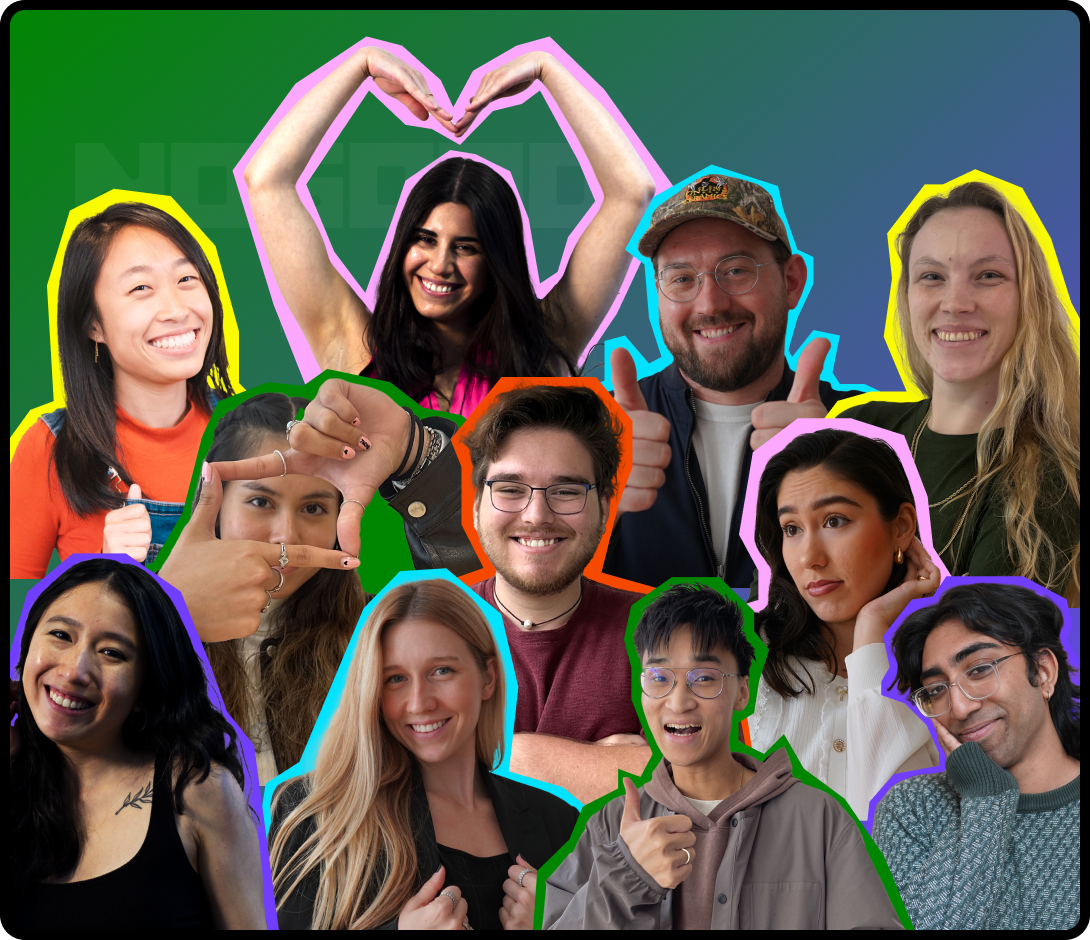
A misconception is that brands need to force employees to participate and be the face of the company’s brand on social media. Truthfully, it doesn’t have to work this way at all. While these initiatives can be internally spear-headed for a brand (with those who volunteer), there is an entirely other realm of EGC to consider and encourage: the personal brands of your employees.
You may be shocked by how many working individuals create content in their free time, directly and/or indirectly, about their experiences at specific companies or industries. By recognizing and nurturing this organic content creation, companies can unlock a wealth of opportunities to enhance their brand image and attract both customers and top talent.
Why Your Brand Needs to Implement EGC Into a Content Marketing Strategy
Employees are the lifeblood of any brand. They serve as the living, breathing manifestation of a company’s identity, playing a crucial role in shaping both internal culture and external perception. So why not use them to enhance your brand marketing?
Businesses that choose to capitalize on the power of EGC in their marketing strategy experienced a notable 27% surge in online engagement and a substantial 19% increase in sales during the first year. These findings underscore the profound impact of employee advocacy on expanding a brand’s reach and enhancing its credibility, which is necessary in the marketplace now more than ever.
The advantages of embracing employees in your content marketing strategy extend far beyond these impressive statistics. Let’s explore the multifaceted benefits that make EGC a game-changer in modern marketing.
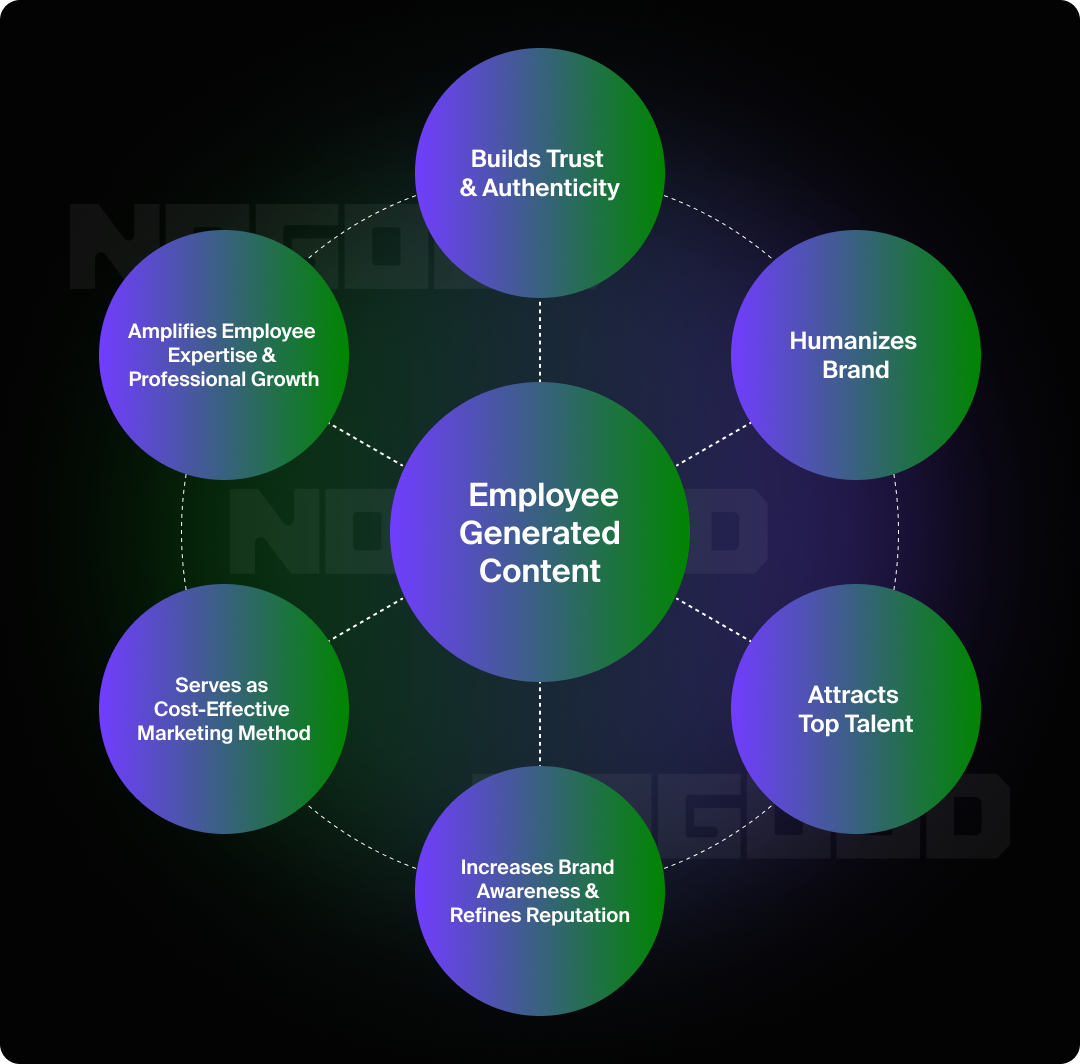
Builds Trust & Authenticity
In spite of traditional company beliefs, employee perspectives compose a more authentic image of the company culture and core values. To the audience, the narrative about a company is more realistic and less performative when it’s shared by an “insider” on their own terms.
People are 3x more likely to trust company information if it’s coming from an employee. Voices coming from inside an organization help brands meet the demand for authenticity in an increasingly skeptical marketplace. You’ve probably heard this phrase time and time again, but it still rings true: People want to buy from people.
This principle expands beyond consumer behavior to the broader marketplace, where individuals (especially GenZ) increasingly demand real connections with the brands they give time and money to. If a brand is actively displaying a real employee experience, they’re able to cultivate a deeper sense of trust and credibility with their audiences.
In a time where skepticism is raging, creating more brand authenticity is crucial to develop customer relationships and loyalty, as consumers are drawn to brands that reflect their values, interests, and beliefs. Ultimately, organizations that embrace and promote genuine voices from within will not only enhance their reputation but also thrive in an environment that demands transparency and sincerity.
Humanizes The Brand
The need to humanize a brand is not a new concept. Traditionally, marketers might use live-streaming, visual branding, user-generated content, and/or personalized email marketing in an attempt to illustrate the human elements behind a brand.
While those tactics certainly work to a degree, EGC accomplishes this goal much more effectively and creatively. Employee voices and experiences molded into a content marketing strategy that are also encouraged to be shared externally, inherently allow a brand to appear more relatable, approachable and genuine.
As these employees share their exposure to a company or industry – via comedic skits or heartfelt narratives – they’re creating a sense of transparency that resonates with audiences. People absorbing this content either relate to the experience, aspire to connect with it, or simply find themselves captivated by the situation, even if they’re not directly involved.
Essentially, employee content functions as a peer review. This is evident in the fact that 54% of consumers trust online peer reviews first, outweighing opinions of friends and family (24%) and company claims (18%).
Attracts Top Talent
The competition to recruit top talent in any industry is intensifying. Employee-generated content has emerged as a powerful differentiator, enabling companies to showcase their company culture and values executed in real life, serving a dual purpose: help organizations initially stand out amongst competitors and serve as the deciding factor for candidates in the final stages of the hiring process.
Through EGC, potential candidates gain real insights into the company culture, allowing them to assess if that culture aligns with their own values and career aspirations. This unfiltered view offers a window into the day-to-day life of current employees, the collaboration within teams, leadership dynamics, and overall work environment. This material provides job seekers with a clearer understanding of what it’s like to be a part of the organization.
The impact of this content marketing approach is not to be diluted, with 88% of candidates saying employer branding influences their decision to apply. This branding ideology naturally extends to social media, where its influence is even more pronounced due to the evolution (and domination) of social search.
At the end of 2024, a striking study found that 79% of job seekers use social media platforms when conducting their job search. Brands need to view these transformative channels as critical touchpoints for potential candidates during the recruitment process.
Companies who effectively leverage their employee voices on social media position themselves at a significant advantage by harnessing EGC across social platforms, not only to attract attention but make an attempt at winning the race for the best talent for their teams.
Increases Brand Awareness & Refine Reputation
According to Linkedin Business Research, an employee network has 10x more connections than organizations have followers. With these large employee networks, brands can strategically encourage and harness their power to enhance brand reach and refine reputation.
Employee-generated content gets shared 24x more than branded content. Let that sink in. Unlike traditional employee advocacy, which relies on employees to share pre-approved company messages, EGC empowers employees to create content in their own unique way.
Airlines have effectively leaned into EGC to combat negative public sentiment and enhance their reputations. United Airlines, Delta, and Emirates have strategically incorporated employee voices into their social media strategies, countering scrutiny over customer service issues and safety concerns.
This approach has proven particularly powerful for the airline industry, where public perception can rapidly shift based on isolated incidents. Let’s quickly explore three impactful employee-generated content social pieces implemented by these airlines.
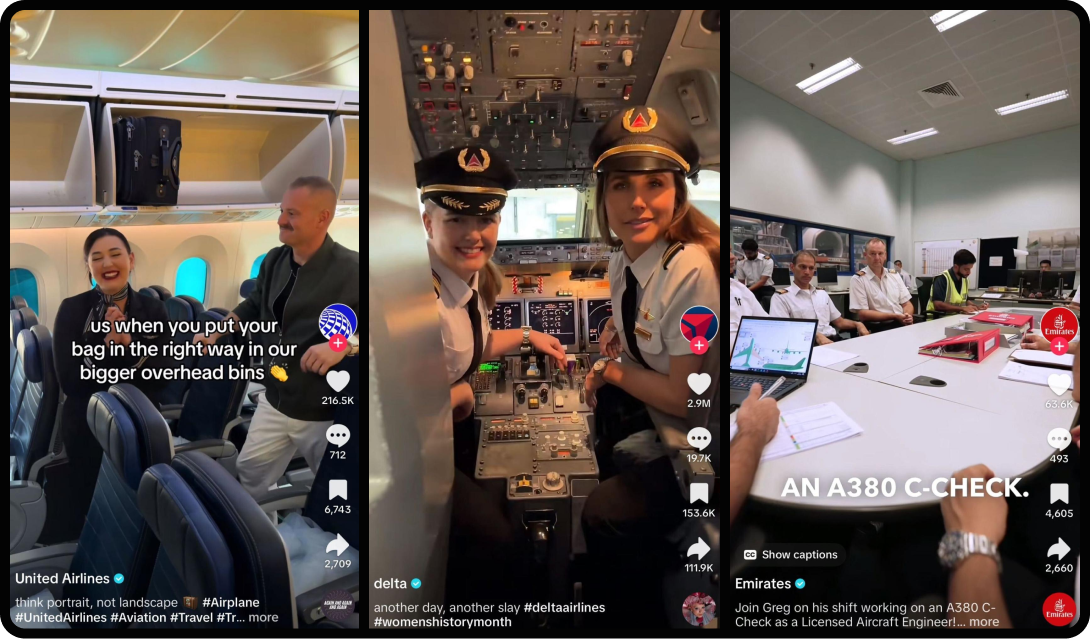
United Airlines’ witty lip-sync skit captures the universal boarding experience, humorously portraying the shared struggles of passengers cramming carry-ons into overhead bins and flight crew’s urgency to expedite the process. This relatable content cleverly transforms a common travel frustration into a comedic moment, creating camaraderie between passengers and airline staff.
Delta’s rotating lip-syncing female staff, from engineers to pilots, creatively highlights the diverse careers held by women within the company in celebration of Women’s History Month. The bold and sassy tone of the trending audio (at the time of publishing), not only underscores Delta’s commitment to empowering women in the aviation industry but also challenges traditional gender norms in a field historically dominated by men.
By showcasing real employees happy in their expert roles in an engaging and relatable way, Delta reinforces its role as a leader in promoting diversity and inclusion while inspiring the next generation of women to pursue careers in aviation.
The Emirates example offers an educational yet fascinating behind-the-scenes look at their aircraft maintenance operations. The video follows an airline engineer, providing an immersive journey from a vast hangar facility to intricate aircraft inspections. EGC social concepts like this unveil the expertise of employees and the complex world of the aviation industry.
Emirates simultaneously addresses safety concerns and commitment to technological advancements via this form of EGC. The airline reinforces passenger confidence and demonstrates an industry-leading position in aviation innovation.
These airlines have strategically implemented EGC, each with a unique approach, to powerfully enhance brand awareness and refine their reputations. The critical takeaway is that EGC isn’t merely a crisis management tool; it’s a proactive strategy for success.
Consistently showcasing company culture and values through authentic employee voices builds a foundation of trust and transparency, differentiating brands in a competitive market and creating a resilient public image. Proactive EGC implementation establishes relatability with audiences that can often withstand potential future PR crises.
Serves as Cost-Effective Marketing Method
EGC offers dual advantages: it’s both budget-friendly and streamlines the content creation process more effectively. Whether employees contribute to brand content or independently create personal narratives about their careers, the cost savings for brands can be significant.
Consider the popular alternative for personable content creation: influencer marketing can be very costly with up to 20% of U.S. companies spending anywhere from $11,000 to $500,000 on campaigns. This type of content creation can get expensive with external, high-end production houses or third-party agencies involved.
However, employees are already living and breathing your brand values. As creators, they require less time for briefings, revisions, and overall mindset adaption. When employees become presenters of social media messaging, they can more efficiently create content that aligns with the brand’s purpose and goals. This insider perspective not only saves money but results in more authentic, relatable content.
Amplifies Employee Expertise & Professional Growth
Employee-generated content also benefits the employee as an individual. Becoming a voice of expertise, relatable personalities, or industry insiders, employees have the potential to gain the following key advantages:
- Personal brand development and career advancement
- Increased job satisfaction and company recognition
- Leadership roles and cross-departmental collaborations
- Skill development in social media and content creation
- Networking opportunities with industry professionals and management
- Enhanced credibility and visibility in professional networks
EGC allows a medium for employees to show their expertise and creativity, potentially leading to recognition as thought leaders in their fields. This skill alone can open many doors. Employees who embrace the opportunity to participate in brand content or boldly share their insights on personal social channels are making a powerful investment in their professional growth and future career success.
How EGC Thrives on Linkedin: Executive-Led Marketing
LinkedIn is a game changer for working professionals dipping their toes into content creation, with or without the intention of promoting their company brand. Additionally, the platform has revolutionized how professionals can share their career journeys, experiences, and expertise. Here, they can expand their networks and establish themselves as thought leaders in their industries.
The impact of this type of EGC is significant: nearly 75% of decision-makers consider an organization’s thought leadership content more trustworthy for assessing capabilities than traditional marketing materials. This underscores just how beneficial employee personalized voices can be for a brand’s credibility and influence.
When reading content on LinkedIn from an individual, it’s natural to associate them with their employer. Consequently, the sentiment and value of an employee’s content is inherently linked to the brand they represent. Let’s dive into two compelling examples of executive-led B2B marketing on the platform, examining their distinct approaches to EGC.
ServiceNow: Bill McDermott
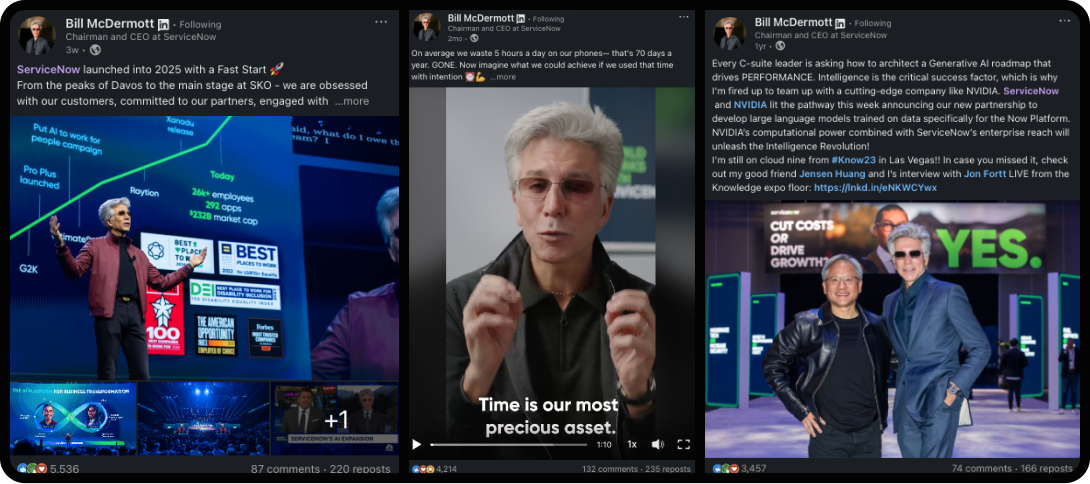
Bill McDermott, Chairman and CEO of ServiceNow, consistently creates thought-provoking content on his personal Linkedin channel. He masterfully blends visionary confidence with relatable authenticity, seamlessly fusing a professional tone with personal charisma. This approach creates a powerfully influential voice that cements his position as a preeminent thought leader across both business and technology sectors. McDermott strategically comments on these four key themes:
- Transformative Company Events, Milestones, and Success Stories: Discusses company insights to highlight rapid growth and industry recognition
- Cutting-Edge Insights on Tech Innovations and Business Trends: Analyzes and contributes his ideology behind AI and digital business transformation
- Shaping His Career Legacy: Illustrates leadership principles through personal stories of resilience and success
- Universal Empowerment for Personal & Professional Growth: Offers encouraging messaging and distinct perspective on universal concepts
McDermott’s Linkedin presence is a strong demonstration of positioning oneself as a thought leader who articulates complex technological concepts and business strategies in an engaging manner. This reinforces his credibility as an industry leader and creates deeper audience connections while exemplifying EGC that indirectly markets ServiceNow, the company he leads.
OKCOOL: Jolyon Varley
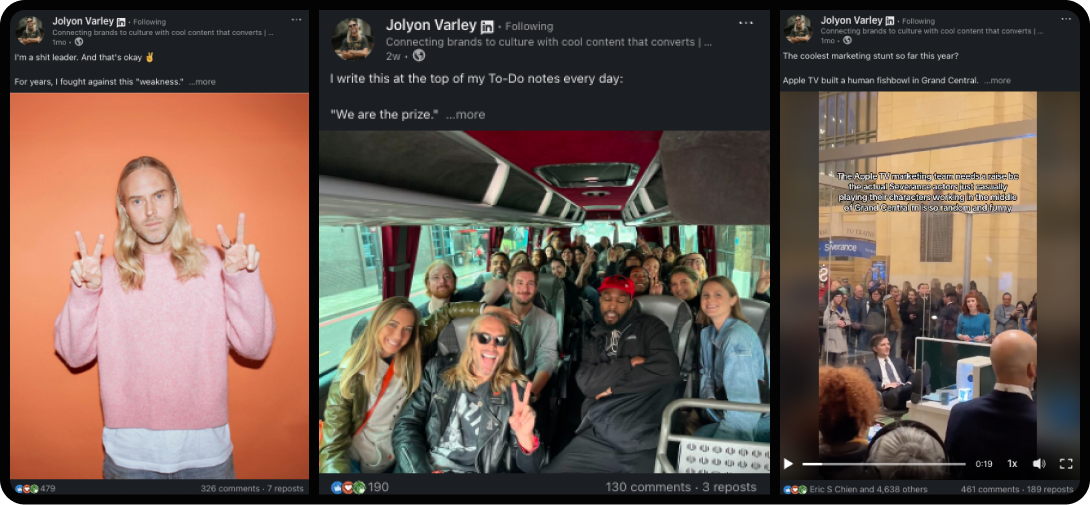
Jolyon Varley, Co-founder of OKCOOL, has captured the essence of EGC with his daily Linkedin content. His edgy delivery and cheeky brand voice stand in stark contrast to the conventional, buttoned-up tone prevalent on the platform, effectively engaging his audience. Varley strategically comments on these three key themes:
- Social and cultural trends in creative branding:
- Analyzes cutting-edge campaigns from brands around the globe
- Explores the delicate balance between counterculture and youth energy
- Offers insights into emerging cultural movements influencing brand strategies
- His raw entrepreneurial journey:
- Shares personal experiences of founding and growing a company
- Discusses challenges and triumphs in the startup ecosystem
- Provides valuable lessons for aspiring entrepreneurs and business leaders
- Thought-provoking, inspirational substance:
- Crafts universally motivating material that resonates across industries
- Addresses broader themes of personal growth and professional development
- Encourages followers to build their own personal brands
Varley stands out as a creator who signifies EGC with his sharp, snappy delivery of trailblazing ideas, which dynamically redefines perspectives of his industry and embodies the mission and values of his company, OKCOOL.
Gen Z’s TikTok: A Playground for Employee Voices
TikTok is a direct line to Gen Z, which is crucial for brands to incorporate into their social media marketing strategies to effectively reach and engage consumers. This specific generation wields significant power and influence over brands due to their large population, digital fluency, and strong emphasis on authenticity and social responsibility. EGC embedded into TikTok content is a must for brands that want to speak to these potential consumers in their own language.
For more justification, social material from employee advocates can generate 8 times more engagement than branded material. Additionally, some EGC posts on the platform have achieved engagement rates of up to 35%, significantly outperforming the industry benchmark of around 1.4%.
This aligns with the growing preference for authentic, relatable content from generations outside of GenZ as well. In fact, 50% of social/video platform users are looking for “content that mirrors their lives,” which EGC encompasses seamlessly.
Here’s how to start and some examples:
- Build Recognizable Faces – Showcase real employees to humanize your brand.
- Leverage Parasocial Relationships – Lean into Gen Z’s emotional investment in one-sided digital connections where viewers feel they know your featured employees.
- Serialize Brand Narratives – Develop storylines around your employees, similar to characters in a TV series, to keep viewers invested and eager for more content.
- Satisfy the BTS (Behind-the-Scenes) Craving – Offer glimpses into company culture, how employees interact in their roles, and different employee personalities to feed Gen Z’s curiosity.
- Tap into the Domination of Comedic Voice – Use humor as a magnet to draw people in. Jump on trending audio/music, chaotic memes, and relatable scenarios to create shareable content that resonates with Gen Z’s experiences in real life.
- Engage Customers with Product Knowledge – Take advantage of employees having a strong understanding of your product to simultaneously entertain potential consumers while educating them on its value.
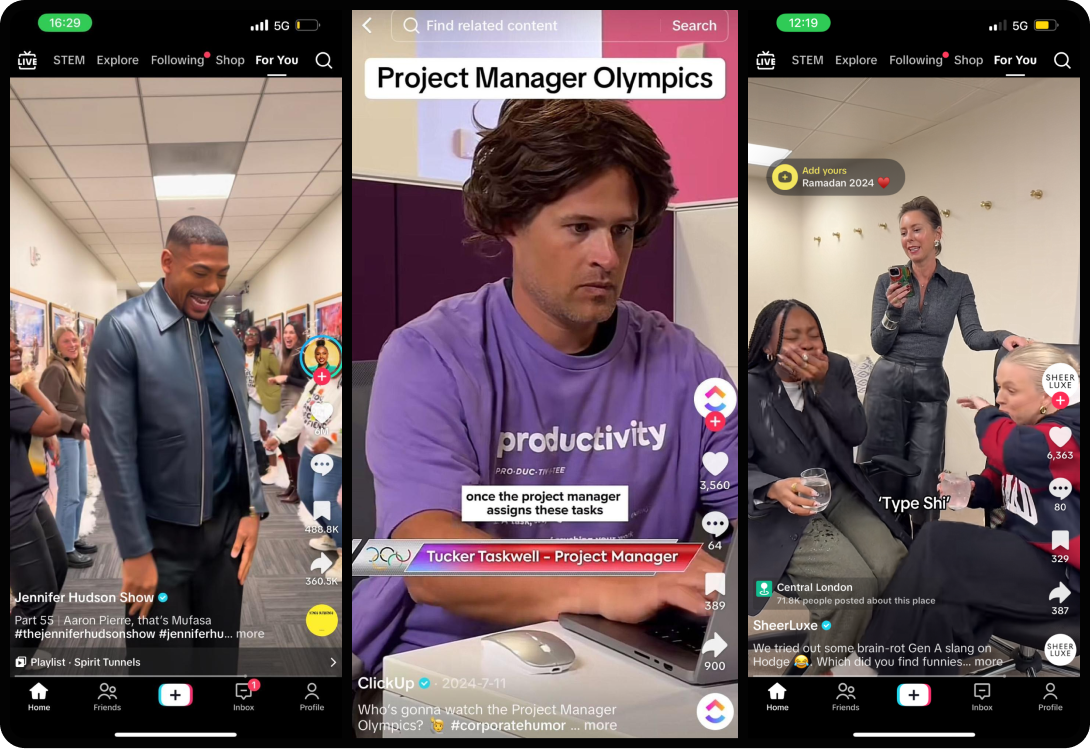
The Jennifer Hudson Show exemplified this point by launching a social media series that features guests walking through a tunnel of employees who creatively compose jingles tailored to the guest star’s name or promotional project. This engaging approach not only highlights employee creativity but also enhances the overall guest experience, making it memorable and shareable. To top it off, they have serialized these content pieces, collecting them in a playlist on the brand’s profile titled, “Spirit Tunnels.”
ClickUp has made their TikTok channel a space for all things corporate humor. ClickUp’s social media strategy brilliantly capitalizes on workplace stereotypes and interdepartmental dynamics. Their content humorously exaggerates the contrasts between Sales and Marketing professionals, or the overzealous participation of HR and IT in company-wide meetings.
The brand’s “Olympics” skits cleverly spotlight role-specific challenges, such as a project manager’s struggle to resist over-communicating across multiple channels. This approach not only entertains their TikTok audience but subtly underscores ClickUp’s value proposition as a streamlined, cloud-based project management solution that addresses these common workplace pain points.
SheerLuxe took on the trending format of Gen Z employees writing scripts for leadership to read off, emphasizing how confused and silly they sound. This concept not only highlights the generational divide in communication styles but also humorously illustrates the stark disconnect between traditional corporate language and contemporary slang.
Unlock the Power of EGC: A Win-Win For Brands and Teams
In essence, employee-generated content is a strategic powerhouse in brand marketing. It brings fresh perspectives that drive business results and attract new customers while nurturing authenticity, boosting brand awareness, and enhancing employee engagement and professional growth. One thing is true about social media, it moves fast. Brands that quickly adapt to shifting trends and customer expectations for personalized communication and targeting online will be the ones dominating their spaces.





